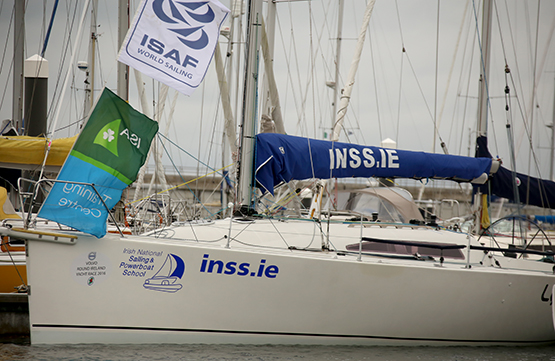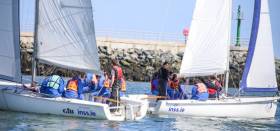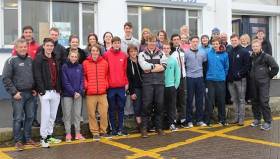Displaying items by tag: INSS
Dun Laoghaire Sailing School Steps Into Strike Day Breach
#INSS - School was out for thousands of teenagers across the country due to yesterday’s ASTI teacher strike – except for one group of students who swapped their classroom for the sea.
The Irish Times reports on the Irish National Sailing and Power Boat School’s special sailing day for pupils affected by the strike on Thursday 27 October.
Fifteen youth sailors who normally take to Dun Laoghaire’s waters on Saturdays got in an early training session, which the sailing school believes would help keep them focused on learning and keeping active in their time off.
The INSS also provides after-school courses for budding sailors, as previously reported on Afloat.ie.
INSS Boat Charter For Frostbite & Turkey Shoot Racing for Adults & Juniors
As the last of the summer racing series in Dublin Bay come to a close, thoughts soon turn to the winter racing series of the DBSC Turkey Shoot & DMYC Frostbite series. Buoyed up by demand, the Irish National Sailing & Powerboat School in Dun Laoghaire Harbour is offering sailors who may not always have the opportunity or access to boats to charter dinghies and keelboats from the Irish National Sailing & Powerboat Schools fleet writes Sailing Shool Principal Kenneth Rumball.
We're delighted to offer our meticulously maintained and race readied 1720s for charter during the DBSC Turkey Shoot and DBSC Spring Chicken Series to past course attendees allowing them to take the next step and race without one of our Team INSS.ie Skippers on board. In addition to the charter, we will also be providing some pre-series coaching to help the team come together and iron out any kinks that may slow you down. More information is available here.
In addition, we will also still be racing our 1720 race boat that is represented at the 1720 class events around the country with spaces available on this boat for those who are less experienced to charter a boat and really want to experience a full on sports-boat raced as hard as possible towards the top end of the fleet.
For the DMYC Frostbite Series we are offering junior and adult sailors alike the opportunity to Charter our fleet of Laser dinghies and Topaz Vibe double handed dinghies.
Uniquely the charter also comes with training weekend before the series to ensure you are fully familiar with your boat prior to racing and pre and post race coaching on the spot. The coaching will primarily be focused on pre and post-race briefings and de-briefings as the racing will be “live”, coaching cannot be delivered during the race. Team INSS.ie skippers will themselves be racing on the very same course. A comprehensive review of the weather forecast and other relevant factors will be covered, with a view as to what tactics can be employed to give each competitor the best advantage. After the race we will review the course, the decisions that the INSS.ie skippers made. In addition, sailors will be asked to share any of their specific experiences from the race.
Full information and pricing is available here.
Irish National Sailing School's Lynx is First School Boat in Round Ireland Yacht Race
INSS School principal and skipper Kenneth Rumball reviews his tenth place overall in Volvo Round Ireland 2016 on board the INSS Reflex 38, Lynx.
The idea for the Irish National Sailing & Powerboat School to compete in the Round Ireland Yacht race was hatched even before the company planned to enter into the yachtmaster business. In fact when selecting a yacht for our competent crew, dayskipper and yachtmaster teaching duties, we made sure to select a boat that could not only fulfil our teaching duties but could look after an amateur crew while also competing at the highest level offshore.
Our Reflex 38 spent her first year primarily away from racing duties before undergoing significant race preparation ahead of this year’s Round Ireland Yacht Race. Our hull was stripped back and freshly antifouled, electronics upgraded, sheets and halyards replaced along will a full sail valet and re-measurement, this all topped off with a full IRC re-measurement in an effort to reduce our TCC ahead of the race.
Meanwhile we started to advertise our campaign for the year ahead which included not only the race but 2 dedicated training weekends along with 4 ISORA training races to ensure our crew was fully prepared along with the boat ahead of this year’s race. Lynx performed well in this training races, coming 4th in the Dun Laoghaire to Holyhead and 5th in the Dun Laoghaire to Isle of Man.
All set for the off – the INSS Reflex 38 in Dun Laoghaire
All set, our crew for the Round Ireland left Greystones Marina on the 18th of June for the race we had been preparing for all year. Keeping our noses clean at the start, we got clear early and made big gains by going close in under Wicklow head to be one of the first boats heading south. Pulling nicely in the first two hours, unfortunately we got stuffed in a no wind hole off Arklow. Going again we made good ground to round Tuskar in the leading pack before heading south into the building breeze. The breeze built and built and in changing down through our sails we unfortunately blew out or number 4 jib, eventually bringing us down to storm jib and two reefs in the mainsail, below is one our crew’s recollection at this time;
“I’ve never done a long offshore race before. In fact I only started sailing in April this year, so to say I was out of my depth on the Round Ireland is an understatement. However, I was somewhat cautious and logical, so I completed a few courses with INSS on the run up to the to the race including Sea Survival. During this course, among other things, I briefly learned about a storm jib and trysail. I was told I would probably never need to use this type of sail, but it was good to know. Come Sunday night off Cork, day 2 of the Round Ireland, the breeze picked up and I watched our torn number 4 headsail being bundled down the companion way with a calm call for the storm jib. Jaaaysus, I thought, storm sails, storm sails? What's next? What was the next module on that course? I think it was boarding a life raft...”
Once we got around the Fastnet, we were able to crack sails for a great yacht up the west coast, it got a bit breezy at one point where we blew out our A5 in about 35kts of breeze off Galway which forced us to move to our S3. With the clearing weather, we had a great sail around Tory Island while we calculated our approach to the notorious tides around Rathlin Island. Much to our surprise, we hadn’t done a good job of getting to Rathlin on time, we had in fact NAILED our timing, giving us a great run down toward Belfast Lough.
In good breeze we continued on a beat down the Irish Sea before being becalmed in Dundalk Bay. Here we struggled on the last night to get into the land breeze where unfortunately some of the lead boats got away… We spent most of the last night drifting trying to sniff any breeze out with the code zero. It wasn’t until the next morning off the Baily that we got going again to sail in good breeze into Wicklow.
Lynx finished after 5 days and 49 minutes in the 2016 Round Ireland, coming 4th in class 3, 10th overall and 1st Sailing School boat! It was a fantastic race where I am ever grateful to the crew who for some it was the longest they had ever spent at sea and who all performed admirably throughout the race, they would be a real asset to any offshore campaign in the future. Special thanks also go to Conor Kinsella and Luke Malcolm whom I really would have struggled without their talent and dedication.
See Round Ireland tracker here Afloat's Round Ireland 2016 coverage is here and download overall results here
Last Sunday, Dun Laoghaire's Irish National Sailing and Powerboat School held its 2016 Open Day in association with Irish Sailing Association's 'Try Sailing' programme.
50 new people to the sport experienced the thrill of sailing onboard a 1720 sportsboat while 64 people enjoyed kayaking and Paddle-Boarding. Check out the video below:
The Irish National Sailing & Powerboat School has been active this winter in anticipation of a busy summer season writes Principal Kenneth Rumball. Through various acquisitions the following additions to the INSS fleet have been made, 13 sit–on Kayaks, five double Kayaks, three rescue boats, 14 Laser Pico Training dinghies, 12 Topper dinghies, two topaz dinghies, three Topper Vibe dinghies, 10 Optimist dinghies and the purchase of another 6.5m fast RIB for our busy powerboat courses.
We have recognised a growing demand at the Irish National Sailing & Powerboat School and we are being proactive in our purchase of equipment ahead of what we hope will be a busier than ever season! Our latest additions show our commitment to continue to be the leading Sailing & Powerboat Training centre in Ireland catering for everybody from the novice power-boater or sailor in dinghies and yachts to a seasoned racer looking to upskill or the experienced power-boater looking to take his skill to the next level. With the current fleet size of sailing and powerboats in the INS&PS standing at over 200 boats, we certainly have the capacity to get everybody on the water.
Our new fleet of course requires more instructors and for this we have been busy training staff not only to fulfil the demands of the Irish National Sailing & Powerboat School but also of the country of Ireland. The Easter break was particularly busy with an ISA Dinghy Instructor Course run before the Easter weekend with 8 attendees and then after the Easter weekend we ran an RYA Dinghy Instructor Course with 18 attendees. We also ran possibly the first RYA Cruising Instructor Course to be held in Ireland over the break, training instructors to the level required to teach up to Day Skipper Practical level on the new ISA and RYA Cruising schemes. Not forgetting the other ISA Dinghy Instructor Courses, RYA Powerboat Instructor Courses that have already been run this year.
Here is a quote from one of our newest dinghy instructors;
“I'm just after completing my dinghy instructor course in the INSS and am so excited now to be able to pass on my skills to younger sailors and adults alike! The course was tiring at times but we all learnt so much and really enjoyed ourselves. It really was a fantastic week and year of training.” - Clodagh Quinn
Now that we have the extra boats and staff in place, we are gearing up for what we hope will be a busy and enjoyable summer.
Dun Laoghaire Sailing School To Contest 2016 Round Ireland Race
2015 was a busy year for the Irish National Sailing & Powerboat School and the school is hoping to be even busier in 2016 writes school principal Kenneth Rumball.
2015 was a huge year of change for the Irish National Sailing & Powerboat School. With thousands of sailors introduced to the sports of both sailing and powerboating at all levels. 2015 saw us invest hugely with the addition of LYNX our first yacht and new powerboats including a 9m and 6.5m RIB. We were delighted to be successful in all areas teaching new persons to sail and introducing old clients to the thrills and spills of dinghy, keelboat and yacht racing.
2016 is already looking to be just as challenging with LYNX currently undergoing a refit ahead of the Round Ireland Yacht race where we have already nearly sold all the places available for the trip around. 2016 will see us invest further in our dinghy fleet with new purchases already underway.
We look forward to helping you in 2016 with whatever course you need.
INSS Sailing Instructors Second at DBSC Turkey Shoot 2015
In an exciting 2015 Dublin Bay Turkey Shoot Race series the Irish National Sailing & Powerboat School Instructors on the 1720 ‘Key Events’ took second place overall while the Irish National Sailing & Powerboat School Race Training programme moved up through the rankings to finish joint 3rd on their 1720 ‘Oi!’
The INSS had their usual entry from their Race Training programme skippered by Kenneth Rumball where Heather Blay, Orlagh Connor, Pete Counihan and David Murphy grabbed the opportunity to race in the series, some with considerable sailing experience and some new to the trials and tribulations of racing. A mixed bag of a series for the race training team with many ups and downs but a great performance from the crew despite some setbacks through the series such as halyards tripping unexpectedly…
New for this year, a number of INSS instructors were keen to race in the series so INSS manager Kenneth arranged a 1720 for them for the series, the team of Calum Paterson, Conor Keane, Will Hamilton, Sara Lanin struggled at the start but thanks to Alexander Rumball joining after the second race, performance increased considerably with the team rising through the fleet to finish second overall.
As usual the race team of Fintan Cairns, Henry Leonard and all the gang on Freebird put on a great series which is gaining hugely in popularity. It was great o see so many 1720s racing this year with a massive 10 boats back racing in the bay.
With the new DBSC sports boat summer sailing coming for 2016, hopefully there is much more racing ahead for the boats.
Yesterday was particularly windy with gusts from the Dublin Bay Buoy of 35kts, never one to shy away, ‘Oi!’ was the first to pop the kite in the big breeze.
11 1720s Battle for DBSC Turkey Shoot Honours
After losing the first two races of the 2015 Dublin Bay Sailing Club Turkey Shoot Series, team Irish National Sailing & Powerboat School on board their 1720 Sportsboat Oi! were keen to get racing last Sunday. With a less than favourable forecast, but more manageable conditions on the day, race officer Henry Leonard & event organiser Fintan Cairns made the call early that we were going racing!
With 11 1720s entered, there were only five who made it to the start line of the first race. Oi! (Team INS&PS Skipper Kenneth Rumball) took the committee boat end of the line with Déjà Vu! (Skipper Ben Cooke) and Lady A (Skippered by RIYC Instructors) taking the pin end, at first it looked like Oi! may have made the right call but Déjà Vu! and Lady A got the early cross ahead of Oi!. By the weather mark, Déjà Vu, and Lady A had a comfortable lead over Oi!, Key Events was not far behind with George (1720 IRL 1780) a little bit late for the start but now in the mix. Down the first run, Déjà Vu and Lady A headed out to the right of the course while Oi!, took an early gybe out to the left of the course into a big gust where the team jumped on the 1720 express train down to the bottom mark where they had closed the gap between them and Lady A to only a few boat lengths. 2 more laps of the gusty windward leeward saw Déjà Vu extend their lead while Oi! managed to overtake Lady A on the last downwind and then extend upwind.
All in all a great windy days racing with a great course and sensible shortening by the race committee.
Irish Sailing Can Take Heart From Dun Laoghaire School’s Latest Record Turnout
Anyone feeling a bit despondent about the future of Irish sailing, what with the disappointing weather for periods of the 2015 season, plus the lack of some really high profile international racing successes, would have had their sprits lifted mightily – and then some – by being around the Irish National Sailing School in Dun Laoghaire last weekend writes W M Nixon
This remarkable organisation, whose background and lively ongoing story we profiled on Afloat.ie on 16th May, have seen their records of numbers participating raised again and again through the summer as the numbers of trainees – from absolute beginners right up to wannabe offshore crews in the school’s Reflex 38 Lynx - have steadily increased, until a new peak was reached last Saturday when absolutely every boat in the club’s large and varied fleet was in constant action, with new participant levels achieved.
Other organisations in the sailing school sector used to wonder in admiration after the INSS began to get regular turnouts of more than 150 schoolchildren per day – when we were visiting on Monday May 10th, 185 schoolkids had been bussed down from Maynooth and were having the time of their lives afloat, many for the very first time.
Nevertheless, while 185 or even 190 participants in the INSS’s schoolchildren division were fairly frequent occurrences, it wasn’t until last Saturday - a great and golden day whatever the weather - that they finally surpassed the 200 mark for members of their Junior Club - aged 7 and over – afloat and learning how best to enjoy the wonders of boats and sailing.
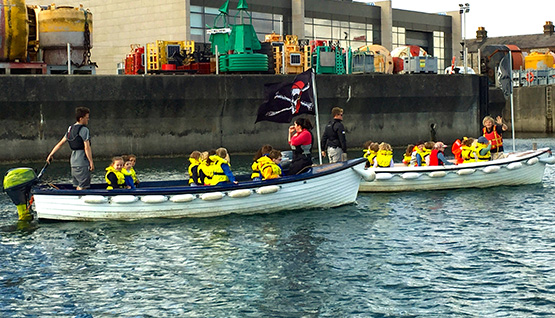 You get them into sailing in gentle stages. With toddlers and infants, just going out on a boat with a feeling of safety is a good first stage – this is Muriel Rumball (lead boat) with the most junior class – some of their parents may themselves be afloat with the INSS learning to sail in larger craft.
You get them into sailing in gentle stages. With toddlers and infants, just going out on a boat with a feeling of safety is a good first stage – this is Muriel Rumball (lead boat) with the most junior class – some of their parents may themselves be afloat with the INSS learning to sail in larger craft.
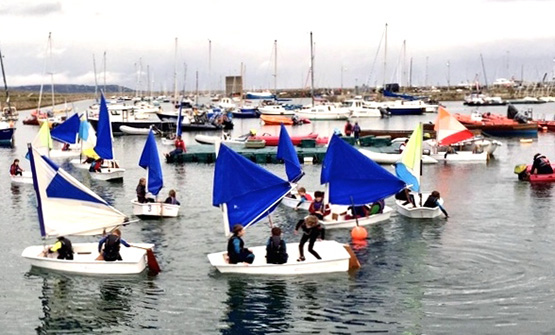 The first stages in sailing should be more about manageability than technical tuning – an Optimist with its sprit out of use lends itself well to fun afloat while gently familiarising the kids with the basics of sailing and getting on with others in the confines of a boat.
The first stages in sailing should be more about manageability than technical tuning – an Optimist with its sprit out of use lends itself well to fun afloat while gently familiarising the kids with the basics of sailing and getting on with others in the confines of a boat.
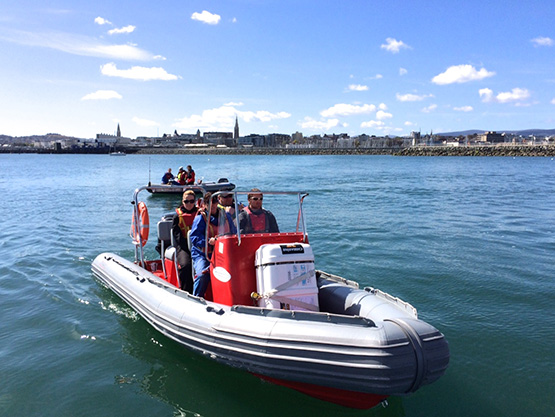 The powerful RIB Sting could be a lethal weapon in the wrong hands, but as she is one of the boats in the INSS Powerboat Course, her competent use is a feature of the school’s activities.
The powerful RIB Sting could be a lethal weapon in the wrong hands, but as she is one of the boats in the INSS Powerboat Course, her competent use is a feature of the school’s activities.
But that was only the start of it, for the school’s popular National Powerboat Course was running for the whole weekend with full turnouts, while the rest of the Schools’ sailing fleet, including 1720s and the Reflex 38 offshore racer, had more than 30 out in adult beginner training courses.
In our report of May 15th, we particularly remembered being in at the beginning of the historic first committee meeting of the newest club in Ireland, the Irish National Sailing Club, which enables the Sailing School alumni to take part in official regattas anywhere, and other open events, for the princely annual subscription of €10.
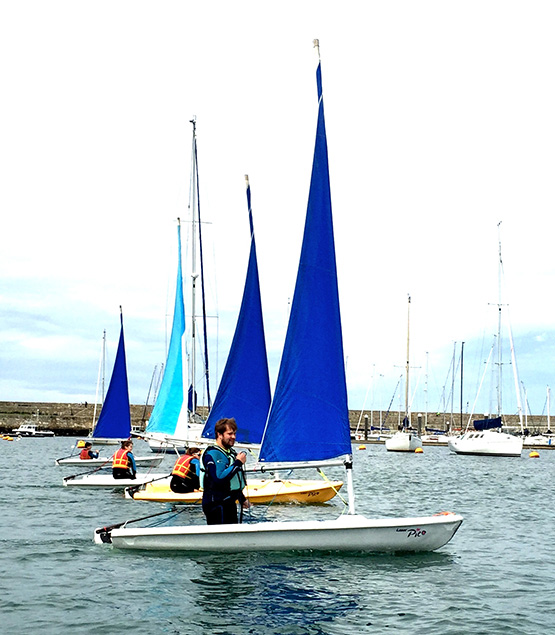 The highly durable Pico is one of the key boats in the INSS’s intermediate courses
The highly durable Pico is one of the key boats in the INSS’s intermediate courses
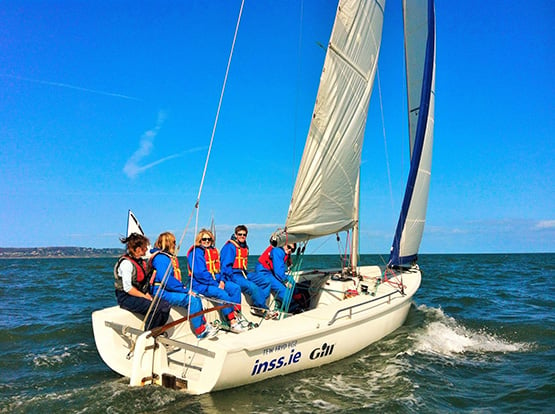 When Tony Castro designed the 1720 Sportboat for a group of Cork Harbour performance enthusiasts back in 1994, he can scarcely have imagined that twenty-one years later a couple of them would be providing ideal training craft for a busy sailing school in Dun Laoghaire
When Tony Castro designed the 1720 Sportboat for a group of Cork Harbour performance enthusiasts back in 1994, he can scarcely have imagined that twenty-one years later a couple of them would be providing ideal training craft for a busy sailing school in Dun Laoghaire
But so worthwhile has the growth and development of the INSC been during 2015 that its members have mustered sufficient numbers to stage their own proper races, and this line of progress also reached a new level on Saturday with the club staging the first INSC Mini-Regatta, with racing for its dinghy classes and well-used Squib fleet.
The regatta even had celebrity participation with noted former international athlete, Senator Eamonn Coughlan, taking part to film part of a documentary called Super Fit Seniors, recording the rapidly improving performance afloat of an 83-year-old whose name we’ve promised not to reveal until the programme is due to be broadcast, but we are allowed to say that if the national policy declares that “Sailing is a Sport for Life”, then on Saturday the INSS was proving it in abundance.
 First committee meeting of the Irish National Sailing Club on Monday May 10th 2015. The committee and school management of the newly-formed Club are (left to right) Glyn Williams (foreground), Muriel Rumball, Joan Sheffield, Caroline Herron, Robin Jones, Alistair Rumball, Kenneth Rumball, Garrett O'Malley, Dermot Igoe, Heather Blay and Mary Beck. Photo: W M Nixon
First committee meeting of the Irish National Sailing Club on Monday May 10th 2015. The committee and school management of the newly-formed Club are (left to right) Glyn Williams (foreground), Muriel Rumball, Joan Sheffield, Caroline Herron, Robin Jones, Alistair Rumball, Kenneth Rumball, Garrett O'Malley, Dermot Igoe, Heather Blay and Mary Beck. Photo: W M Nixon
Such is the stature of the Irish National Sailing School that it has been selected as the venue for one of the key assemblies in the up-coming series of Irish Sailing Association Regional Cluster Development Meetings, which seek to improve inter-club relationships and facilitate regional co-operation for the mutual benefit of the many and varied club memberships in specific areas.
The ISA East and Southeast Regional Development Officer Sarah-Louise Rossiter will be holding the meeting for sailing and yacht clubs in the Dublin South Cluster in the Irish National Sailing School from 7.0pm to 9.0pm on Wednesday October 7th.
We can only hope that some of the stardust now exuding from the INSS will waft on to those from other clubs. Alistair Rumball, founder of the INSS way back in 1974, helpfully explains how it’s done: “There’s nothing special to it. You just have to have everyone prepared to work 15 hours a day seven days a week, and be mad keen about teaching and sailing. That’s all it is. Simple as that really”.
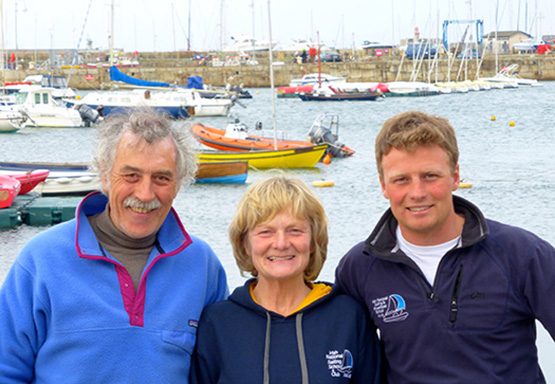
The National Sailing School’s Alistair and Muriel Rumball and their son Kenneth. “You just have to have everyone prepared to work 15 hours a day seven days a week, and be mad keen about teaching and sailing. That’s all it is. Simple as that really”.
#inss – Last week, Sailing on Saturday featured the Royal Cork Yacht Club, the oldest in the world, as it comfortably donned the mantle of the ISA/Mitsubishi Motors Sailing Club of the Year 2015. This morning, we find ourselves involved with what may well be the newest sailing club in the world, the Irish National Sailing Club. It is certainly, thanks to being inaugurated nearly three months after Youghal SC was founded on 28th October 2014, the newest in Ireland. W M Nixon tries to explain it all as he finds himself in the world of Irish sailing's most complete dynamo.
Alistair Rumball is a Life Member of the Awkward Squad. Cage-rattling and pot-stirring are second nature to him. But it's not because of experiencing an unhappy childhood. On the contrary, while growing up in Malahide, his boyhood summers were bliss. He and his brother Arthur had as much sailing as they could want, fitted in between part-time jobs raising pocket-money with a morning picking potatoes at Dermot Dickie's farm along the Broadmeadow Estuary, followed by an afternoon of sailing the sea with the sun always shining, and then maybe an evening of club racing followed by the easy camaraderie among kids who are comfortable with boats.
It was an idyllic maritime environment which, over the years, has produced some of Ireland's top racing and cruising sailors. But while the young Rumball was no slouch on the race-course, the strongest feeling he had about sailing was the sheer fun of it all, the totally absorbing wonder of being in a boat and hauling on ropes to make sails change shape and help you along your chosen course over the always interesting sea.
Although he graduated from Trinity College Dublin as an engineer, he increasingly had this almost evangelical attitude to spreading the good news about the fun of sailing. And while he has something of a reputation – to say the least - for being confrontational, it's central to his contradictory character that he's an extremely good teacher. If somebody shows the slightest genuine enthusiasm about wanting to learn to sail, Alistair Rumball has been prepared to go to endless lengths to teach him or her to do so, and to do so with enjoyment.
Underlying that, we find the first of his gripes about the modern sailing scene. He reckons that it has become far too serious. Don't think for a moment, though, that he believes in a frivolous approach to boats and sailing. He's deadly serious about having everything just right as regards safety and function.
But once that's sorted, then he firmly believes that you should go out and enjoy it. He waxes lyrical about moments of sheer sailing ecstasy he has enjoyed in a wide variety of boats in many sailing locations worldwide. And whatever he may have formally set out to be in a professional career, his working life has been spent in and around boats, getting people introduced to boats and out afloat, sometimes on an almost industrial scale.
Time was when sailing skills were something you acquired by a sort of osmosis through family tradition, club opportunities, and friendship examples. That's mostly how Rumball himself learned to handle a sailing boat. But he seems to have this almost messianic zeal to teach people to sail, and he became convinced that the future lay in more structured training with a proper syllabus.
Having taken a long hard look at the population distribution of the Greater Dublin area and where they might best get afloat in worthwhile numbers, in 1978 he acquired the assets of a moribund organisation, the Dun Laoghaire Sailing School, and soon found himself giving his first lessons to two pupils using a fibreglass-clinker Darragh 14 knockabout sailing dinghy which they'd launched from the public slipway in the Coal Harbour in Dun Laoghaire. The long journey had started towards an organisation whose activities today today include top-of-the-line race training in 1720s in winning mode:
The majestic granite harbour of Dun Laoghaire was a cold place in 1978 for any young enthusiasts trying to set up an independent sailing school on a commercial basis. For the powers that be, sailing was something to be learned through family and clubs under the Junior Training Programme of the Irish Yachting Association. If you were a young person or adult from a non-sailing background but keen to learn, unless you'd an obliging and patient friend from within the sailing establishment, the expectation was that you'd take yourself off to somewhere far away like the Glenans Ireland bases in Baltimore and Bere Island and Clew Bay, and eventually reappear after a decent interval with enough experience, newfound ability and contacts to make the grade in the Dublin Bay sailing scene, where the very thought of a raw in-harbour sailing school for outsiders seemed distasteful to the establishment.
Yet hidden away in the southwest corner of Dun Laoghaire harbour, here was this gadfly of the sailing scene, Can–do Alistair with his rough and ready sailing school enthusiastically recruiting pupils anywhere and everywhere, and taking them afloat in boats which may not have been in the most pristine condition, and certainly set sails which would not be winners on the race course, yet they were safe and able, and so were he and his instructors.
Over the years, an entire cohort of people, mainly from Dublin but also from all over Ireland with a useful smattering of pupils from abroad, came to boats and sailing thanks to this wild-haired character whose love of his demanding work shone through everything he did.
Gradually the fleet expanded, and so too did the "Rumball Group's" activities, even though the very limited availability of premises on the Dun Laoghaire waterfront meant that every little square foot they had always seemed to serve at least three different purposes. But they were getting there, they opened a retail outlet in the town to sell boat gear and equipment which became Viking Marine, the school promoted itself to being the Irish National Sailing School, and they were well settled in place, using every inch of space on the ground floor of the interesting little building on the southwest corner of the harbour which used to be the Nautical College.

The man and his machines – Alistair Rumball and his chariot outside the Irish National Sailing School's HQ in Dun Laoghaire. Photo: W M Nixon
Centuries ago, seafaring education was given a significant role in Irish life in the late 1700s, the 1800s, and the early 1900s with the old Marine School a fine building on the south quays in Dublin. But its premises were re-allocated for development purposes and the school itself had its final home in Clontarf before being absorbed only as a vague memory into what is now Mount Temple Comprehensive school.
These days, the marine education focus has moved to Cork with the fabulous new National Maritime College in Ringaskiddy, but for that low period in Irish maritime life in the mid 20th century, one of the few keepers of the flame was Captain Tom Walsh who operated the little Nautical College in this fairly inconspicuous Office of Public Works building now hidden away behind the Dun Laoghaire Motor Yacht Club.

Captain Tom Walsh in teaching mode in 1957 in the INSS building when it was the Nautical College.

The 110ft barquentine which Jack Tyrrell designed for Captain Tom Walsh's Nautical College in 1954 in the hope that it would inspire the building of an Irish Tall Ship
It was the gallant Captain Walsh who in 1954 commissioned Jack Tyrrell of Arklow to design a 110ft sailing ship – a barquentine – to be Ireland's very own tall ship, our first sailing training vessel. God bless the good captain, but he was convinced that if he could just get someone in Government to see these inspiring plans, then such a ship would be on the way.
You can imagine just how far such a visionary idea travelled in the deadly dull Ireland of the 1950s. Far from getting a proper training ship built, Captain Walsh had enough trouble keeping his college in being. Yet he was a gentleman and enthusiast to the end, and after retirement he augmented his pension by testing compasses in yachts, which I remember well as he did it for me with a little cruiser in 1981. The only mutually convenient time it could be done was on a Saturday evening, and I'd to get the boat from Howth to Dun Laoghaire to do it, but the actual swinging of the compass by Tom Walsh was such a pleasant and educational experience that any thoughts of being at some Saturday night party were entirely banished.
So when you go into the main premises of the Irish National Sailing School today, it's natural to remember Captain Tom Walsh, and I like to think that he would thoroughly approve of the old building's current usage, for Alistair Rumball and his team are mighty busy during what must sometimes be an 18-hour day, and just this week – before the sailing season is really fully under way – Monday was typical, with 185 schoolkids bussed down from Maynooth for a day's coaching afloat, followed by all sorts of gatherings including a committee meeting of the newly-formed Irish National Sailing Club.
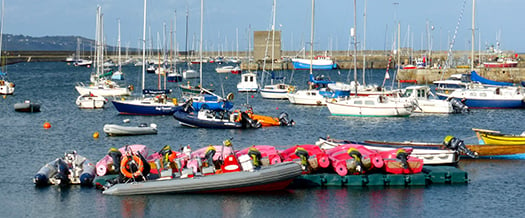
Space is so constrained that a floating dinghy park has to be used to store the smaller craft. Photo: W M Nixon
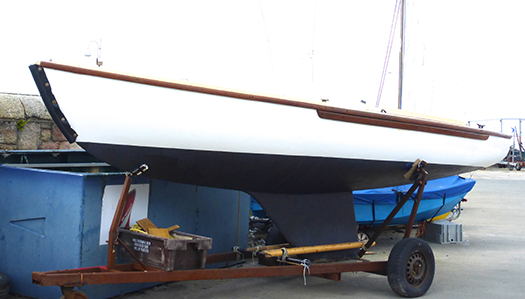
Thanks to the special INSS fendering devised by Arthur Rumball, this 35-year-old Squib has survived many seasons of tough teaching in good order. Photo: W M Nixon
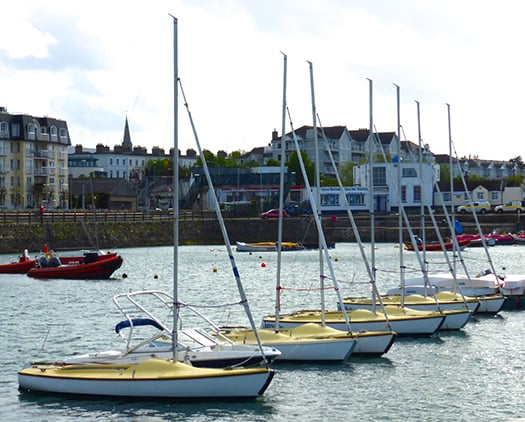
To economise on space, the Squibs berthed here, with the INSS building in the background, are double-moored. Photo: W M Nixon
Of which more anon, for this bare outline gives only a hint of the INSS's complex programme. The Rumball theme is that you have to keep operations and facilities flexible to cope with fluctuating demand, for at the height of the season the school is operating a fleet of 200 boats ranging from kayaks through sailing dinghies of increasing size, then on into keelboats of which some well-fendered Squibs are the workhorses while 1720s provide the glamour input, and finally at the top of the tree there's the Reflex 38 Lynx, bought from Galway this past winter, and becoming part of a programme headed by Alistair's son Kenneth – a Silver Youth Medallist in the 420 – who is now a fully-qualified offshore racing pro teacher, but also races the 1720s while being main operations director of a school which has five full–time employees, but in all has sixty staff at the height of the season.
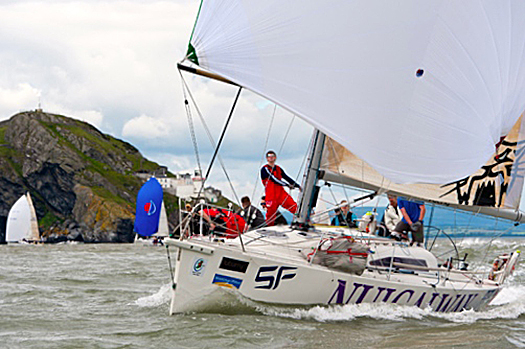
The latest addition to the INSS fleet is the Reflex 38 Lynx, seen here racing for NUI Galway during the Round Ireland. In 2015, Lynx has already scored a second overall in ISORA racing skippered by Kenneth Rumball.
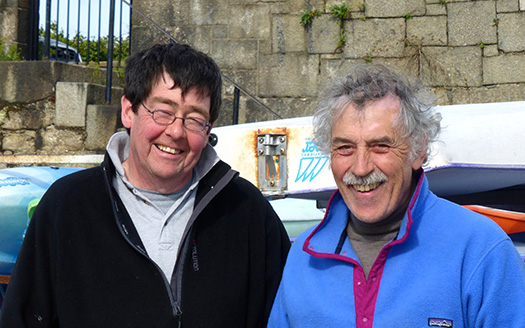
Brothers in business – seen here with his brother Alistair, Arthur Rumball (left) runs the often very busy INSS boat maintenance facility. Photo: W M Nixon
As to shoreside facilities, each summer they set up an additional seasonal summer base to the west of the West Pier with top-of the-line Portakabins at Salthill to provide facilities for those sailing dinghies and kayaks, and in addition the INSS have their own boat-maintenance unit under Arthur Rumball beside the boatyard in the Coal Harbour.
So an impressive amount of things have happened since 1978, the best of them surely being that Alistair persuaded Muriel, a country girl from one of the most beautiful parts of County Carlow, to marry him. For Muriel is a teacher by profession, and adept at being the peace-maker who smooths the waters after Alistair has been making waves, which even now still seems to be just about all the time.
That said, he gives the impression of having so many chips on his shoulder about the perceived opposition to his ventures by those in authority that you begin to think it might be just a bit of an act, for underneath it all he has a heart of gold, yet with the spirit of a lion who will fight the good fight to defend his territory and the interests of his family, friends, trainees and businesses.
The quality of the man was well revealed when the economic recession struck. At the height of the boom years, the Irish National Sailing School had a throughput of more than 2,500 people per month coming new to sailing, and it had become a vibrant and trendy part of the recreational fabric of good-time Dublin. Then around 2008, the economy went into free-fall. But the INSS survived both by making severe cutbacks in everything, and utilising another string in Alistair's bow.
Because of his ready enthusiasm to undertake just about everything and anything to do with boats, back in 1982 he'd looked after some waterborne scenes with classic small craft for the Channel 4 TV comedy-drama series The Irish RM, starring Peter Bowles and Bryan Murray, which went out between 1983 and 1985. It was grand at the time, but thirty years down the line it now seems to have a dose and more of the Paddywhackery about it. However, that was neither here nor there for Alistair Rumball in 1982, for it gave him a lucrative little sideline, and over the years since he has been the man to go to if you want to set up boats and sailing ship scenes in the Irish movie-making business.
So it's ironic, when we remember that Malahide was where the rather mouldy old Vikings of Dublin made their last base after their city had been captured by the Normans in 1171, that it should be a Malahide boy who has emerged as the behind-the-scenes captain of ships for the filming of the blockbuster series Vikings.

When you've spent most of your working life teaching people to sail, tutoring Thespian Viking crewmen on a Wicklow lake is just an ordinary part of another day at the office.
It has all been happening for some years now up in the Wicklow mountains and out on the Wicklow lakes, which have passed themselves off very well as Norwegian fjords, yet can double quite effectively as the coastal and riverside scenery of the many places where the Norwegian Vikings wreaked mayhem.
Who knows, but maybe with the passage of time the epic Vikings series will come to be seen as the epitome of Scandiwhackery, but for now, it certainly does the business . For as the Irish economy fell off a cliff, Alistair Rumball soared aloft in creating, managing, and manoeuvring a very authentic and substantial Viking longship flotilla which has provided a proper Tinseltown income to make all things possible, while helping underwrite the future of the Irish National Sailing School.
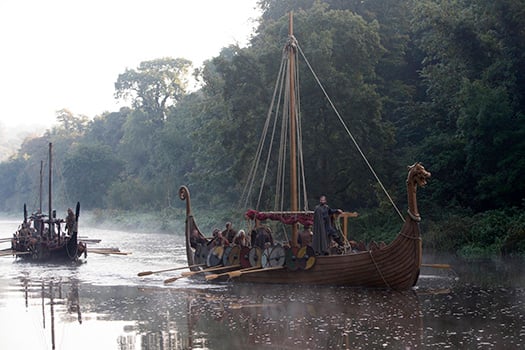
Lough Dan in County Wicklow - where Erskine Childers first sailed around 1890 – has proved remarkably versatile in providing backgrounds for the Vikings which could either be Norway itself, or else the shores of places they are raiding
But it's extraordinarily demanding and time-consuming work, even if he has a staff of 150 specialists up in the Wicklow hills, and after a year or two it became clear that he was trying to do too much. So four years ago his son Kenneth, who is now 27 and was at the time working as an accountant, moved in to take over the direction of the sailing school, and as the recession has started to recede – last year they had monthly numbers pushing back towards the 2,000 mark - Kenneth's energetic and all-encompassing input is seeing the school increasing the scale of its operations, particularly in what might be called the post-graduate side with the development of 1720s at top race level. Now the acquisition of Lynx has developed things further - she has already made what was a rather hasty debut in the first ISORA of the year, but despite being only minutes out of the box, they placed second overall, and that only by six minutes.
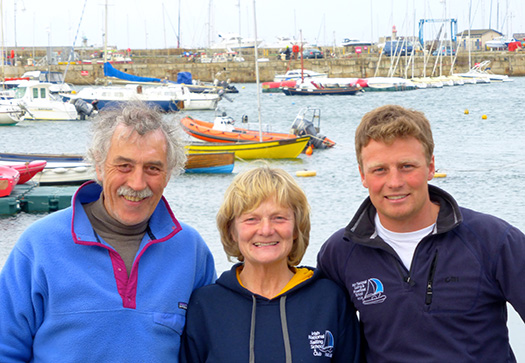
Alistair, Muriel and Kenneth Rumball. Photo: W M Nixon
This placing of racing as a natural part of the INSS syllabus has in turn led to the need for an officially-constituted club to comply with race entry requirements. But in reality the INSS has had a genuine club atmosphere for years, indeed it has more of a truly club-like atmosphere than many a historically-constituted old yacht club. So it was only a formality to bring the Irish National Sailing Club into being in January 201, but it's for real, here's a pic of the Committee of the new club meeting in the old Tom Walsh building on Monday, and if you want to join, it will cost you the outrageous sum of €10.
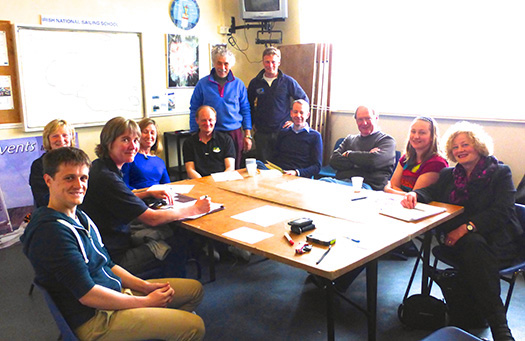
The committee and school management of the newly-formed Irish National Sailing Club are (left to right) Glyn Williams (foreground), Muriel Rumball, Joan Sheffield, Caroline Herron, Robin Jones, Alistair Rumball, Kenneth Rumball, Garrett O'Malley, Dermot Igoe, Heather Blay and Mary Beck. Photo: W M Nixon
As to how Alistair Rumball views the impending possible re-structuring of Dun Laoghaire as a cruise liner port, with inevitable limitations on the amount of sailing which can take place within the harbour, he is both an idealist and a realist.
Like many of us, he dearly wishes that this splendid granite creation could be seen as a cherished part of our heritage, not as something to be used to generate income to turn a crude profit or even just to pay its own maintenance costs. Rather, we'd ideally like to see it treated as a national asset to provide vital recreational space for everyone afloat and ashore.
But Alistair Rumball senses that the government's determination to use just about everything in public ownership to generate income will win the day, and he is already being realistic about what the regular if summer-emphasised arrival of cruise liners will mean.
In fact, he may even derive a certain sardonic satisfaction from seeing the Dun Laoghaire sailing establishment having to contemplate accepting conditions with which his school has complied ever since he began operating it.
"People should realise" he asserts, "that there are already two clearly-define shipping channels in Dun Laoghaire Harbour. One is from the harbour entrance to St Michael's Wharf, which will simply be retained if the cruise liners come. The other, much less widely known, is supposed to be from the harbour entrance to the berth at the Band Stand on the East Pier. Even at present, you are not meant to operate under sail in either of those channels, but an awful lot of boats do so."
"However, as we are a commercial operation, we have a strict policy of complying with regulations and carrying out our sail training and teaching operations in the western part of the harbour, clear of the main channel. So a cruise liner should not affect our in-harbour activities, while our larger craft going out into the bay will have to comply with shipping regulations in the entrance like everyone else".
Whatever happens, we may be sure that the Irish National Sailing School and the Irish National Sailing Club - and their splendid founder - will continue to be a thorn in the side of those who take themselves too seriously and have an inflated idea of their own importance. But if you've never been in a boat before and know nobody in sailing, yet feel a growing enthusiasm to go sailing in Dun Laoghaire, you now know where to go to experience the real thing.
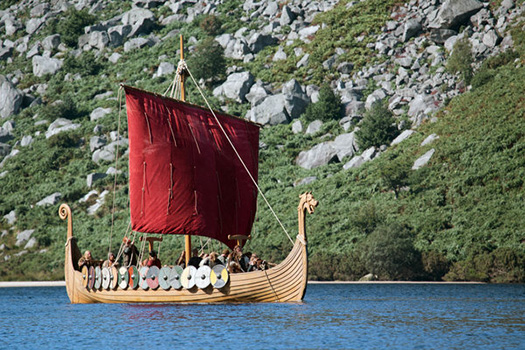
The other side of the INSS show – a Viking ship looking good on Lough Dan






























